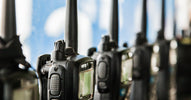
Programming Icom Radios for Multi-Shift Operations
, by Jesus Moraga, 6 min reading time

, by Jesus Moraga, 6 min reading time
In large operations, teams often work across different shifts. When teams are unaligned, miscommunication happens, handoffs are chaotic, and management scrambles to fix preventable communication problems. Miscommunication can bottleneck productivity and create safety concerns, but it doesn’t have to be this way.
When configured correctly, Icom radios are very effective. Properly programming Icom radios for multi-shift operations can turn confusion into clarity and save your team time, stress, and effort.
This guide will show you how to set up your radios for success by organizing channels, standardizing usage, ensuring compatibility, and providing training. By the end, you’ll be ready to set up communication systems that operate seamlessly.
From emergency services to large-scale industries, Icom two-way radios support clear, immediate communication in operations that run around the clock or rely on overlapping shifts. Manufacturers made these radios adaptable to the demands of many industries to accommodate specialized workflows.
No matter the field, these radios give teams the communication tools they need to stay organized, act quickly, and meet the demands of their work.

Multi-shift operations rely on immediate communication. When radios aren’t programmed correctly, teams deal with missed messages, cross-channel chatter, and delays. Programming radios with intention prevents problems and keeps work moving.
With an organized channel set up, teams reach the right people without wasting time. A well-planned system keeps production on schedule, helps staff respond quickly to safety issues, and makes it easy to find the right channel when it counts.
To get the most out of your Icom radios, you need a straightforward channel structure that aligns with your team’s workflow. Here’s how to tackle it:
Give specific shifts their own dedicated channels to prevent cross-talk and miscommunication. For example, use Channel 1 for the day shift, Channel 2 for the evening shift, and Channel 3 for the overnight shift. Separating the channels keeps conversations clear and reduces overlap between different shifts.
For larger teams, divide channels based on departments or roles. Teams like maintenance, security, and managers all have different priorities. Use separate groups of channels for these functions to keep everyone’s communication focused. For instance, Channels 4–6 can handle maintenance for all shifts, while Channels 7–9 are for security teams.
By breaking down channels based on shifts and roles, you create a logical system that simplifies communication and reduces downtime caused by confusion.
Clear channel labels make communication faster and easier for your team. Avoid cryptic codes or unclear abbreviations and choose descriptive names that immediately identify the channel’s purpose. For example, label a channel “Day Shift Security” or “Night Shift Maintenance.”
Many Icom radios allow you to program custom channel names, which appear directly on the screen. Use this feature to simplify navigation for your team, reducing the chance of mistakes and keeping everyone focused on their tasks.

Operating a mixed fleet of two-way radios requires careful coordination to maintain consistent communication. Match the radio frequencies, whether they’re very high frequency (VHF) or ultra high frequency (UHF), and set up channels that allow devices to work together without interruption. If your team uses both digital and analog radios, configure channels in a “mixed mode” where they can interact.
Use tools like Icom’s CS series software to program and synchronize devices across your operation. Regularly test the setup to confirm that all radios work together, regardless of their model or age. With the right configurations, your team can communicate reliably without so many device limitations.
Thorough training helps your team use these radios efficiently and correctly. Start by covering the basics, such as switching channels, adjusting volume, and using emergency features. Walk your team through the channel layout so they understand where to communicate for specific needs.
Provide practical tools like a quick-reference guide or cheat sheet to reinforce learning. These resources give team members a way to refresh their knowledge when they need it. Hands-on training sessions combined with accessible reminders build your team’s confidence and communication skills.
Over time, as you adopt new workflows, add team members, or adjust shift responsibilities, your communication needs will change. When you revisit and update the programming, you keep the radio system aligned with your team’s workflow.
When you review your configuration, listen to employee feedback about channel use and communication problems. Check if your current channel organization supports your new workflows. Updating your radios directly improves communication and removes persistent inefficiencies.
With Icom radios set up for your organization’s needs, the benefits are immediate and far-reaching:
These advantages make programmed radios a driving force behind your team’s success.
Programming Icom radios for multi-shift operations allows better communication, reduces errors, and empowers your workforce. You can start with a smart channel setup that suits your organization and finish with thorough training.
If you’re looking for expert help in fine-tuning your Icom radios, Atlantic Radio Communications has you covered. Our team specializes in all things two-way radios and can meet the unique needs of businesses like yours. Reach out to our dedicated team today to take the guesswork out of programming your team’s communication network for any shift or challenge.